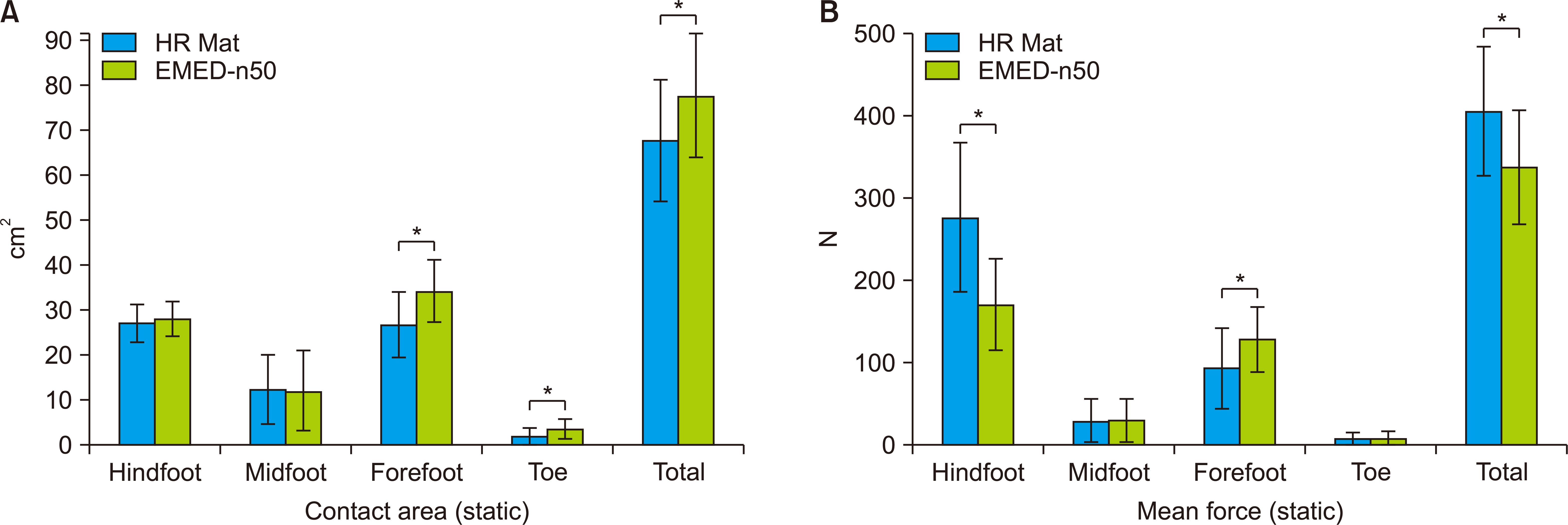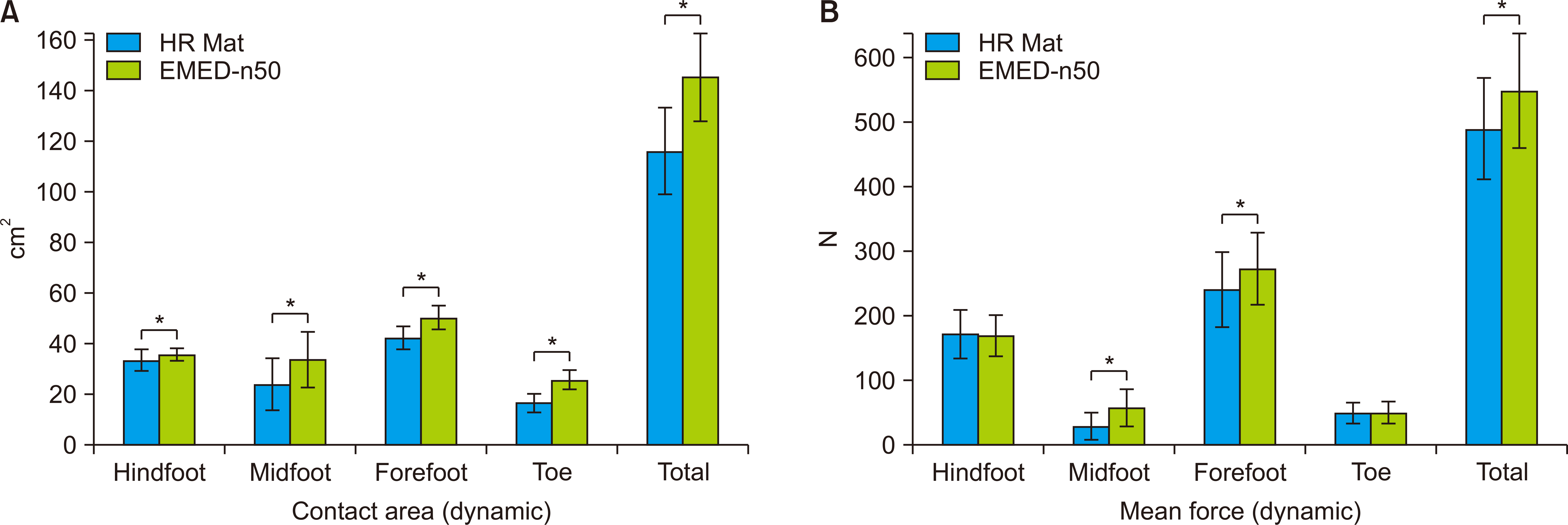J Korean Foot Ankle Soc.
2024 Mar;28(1):21-26. 10.14193/jkfas.2024.28.1.21.
Comparative Analysis of Two Pedobarography Systems
- Affiliations
-
- 1Department of Orthopedic Surgery, Seoul National University College of Medicine, Seoul, Korea
- 2Department of Orthopedic Surgery, Ewha Womans University Mokdong Hospital, Seoul, Korea
- 3Department of Orthopedic Surgery, Busan Paik Hospital, Busan, Korea
- 4Department of Orthopedic Surgery, Han-il General Hospital, Seoul, Korea
- 5Department of Orthopedic Surgery, Seoul National University Hospital, Seoul, Korea
- KMID: 2553805
- DOI: http://doi.org/10.14193/jkfas.2024.28.1.21
Abstract
- Purpose
Foot pressure measurement devices are used widely in clinical settings for plantar pressure assessments. Despite the availability of various devices, studies evaluating the inter-device reliability are limited. This study compared plantar pressure measurements obtained from HR Mat (Tekscan Inc.) and EMED-n50 (Novel GmbH).
Materials and Methods
The study involved 38 healthy male volunteers. The participants were categorized into two groups based on the Meary’s angle in standing foot lateral radiographs: those with normal feet (angles ranging from –4° to 4°) and those with mild flatfeet (angles from –8° to –15°). The static and dynamic plantar pressures of the participants were measured using HR Mat and EMED-n50. The reliability of the contact area and mean force was assessed using the interclass correlation coefficient (ICC). Furthermore, the differences in measurements between the two devices were examined, considering the presence of mild flatfoot.
Results
The ICC values for the contact area and mean force ranged from 0.703 to 0.947, indicating good-to-excellent reliability across all areas. EMED-n50 tended to record higher contact areas than HR Mat. The mean force was significantly higher in the forefoot region when measured with EMED-n50, whereas, in the hindfoot region, this difference was observed only during static measurements with HR Mat. Participants with mild flatfeet exhibited significantly higher contact areas in the midfoot region for both devices, with no consistent differences in the other parameters.
Conclusion
The contact area and mean force measurements of the HR Mat and EMED-n50 showed high reliability. On the other hand, EMED-n50 tended to record higher contact areas than HR Mat. In cases of mild flatfoot, an increase in contact area within the midfoot region was observed, but no consistent impact on the differences between the two devices was evident.
Keyword
Figure
Reference
-
1. Cavanagh PR, Rodgers MM, Iiboshi A. 1987; Pressure distribution under symptom-free feet during barefoot standing. Foot Ankle. 7:262–76. doi: 10.1177/107110078700700502. DOI: 10.1177/107110078700700502. PMID: 3583160.
Article2. Menz HB, Zammit GV, Munteanu SE. 2007; Plantar pressures are higher under callused regions of the foot in older people. Clin Exp Dermatol. 32:375–80. doi: 10.1111/j.1365-2230.2007.02421.x. DOI: 10.1111/j.1365-2230.2007.02421.x. PMID: 17425648.
Article3. Nagel A, Fernholz F, Kibele C, Rosenbaum D. 2008; Long distance running increases plantar pressures beneath the metatarsal heads: a barefoot walking investigation of 200 marathon runners. Gait Posture. 27:152–5. doi: 10.1016/j.gaitpost.2006.12.012. DOI: 10.1016/j.gaitpost.2006.12.012. PMID: 17276688.4. Jahss MH, Kummer F, Michelson JD. 1992; Investigations into the fat pads of the sole of the foot: heel pressure studies. Foot Ankle. 13:227–32. doi: 10.1177/107110079201300501. DOI: 10.1177/107110079201300501. PMID: 1624185.
Article5. Ellis SJ, Hillstrom H, Cheng R, Lipman J, Garrison G, Deland JT. 2009; The development of an intraoperative plantar pressure assessment device. Foot Ankle Int. 30:333–40. doi: 10.3113/FAI.2009.0333. DOI: 10.3113/FAI.2009.0333. PMID: 19356358.
Article6. Skopljak A, Muftic M, Sukalo A, Masic I, Zunic L. 2014; Pedobarography in diagnosis and clinical application. Acta Inform Med. 22:374–8. doi: 10.5455/aim.2014.22.374-378. DOI: 10.5455/aim.2014.22.374-378. PMID: 25684844. PMCID: PMC4315649.
Article7. van der Leeden M, Steultjens M, Dekker JH, Prins AP, Dekker J. 2007; The relationship of disease duration to foot function, pain and disability in rheumatoid arthritis patients with foot complaints. Clin Exp Rheumatol. 25:275–80.8. Lee KB, Kim BR, Lee KS. 2018; Effects of toe spreader on plantar pressure and gait in chronic stroke patients. Technol Health Care. 26:957–62. doi: 10.3233/THC-181316. DOI: 10.3233/THC-181316. PMID: 29966214.
Article9. Marey ÉJ. 1873. De la locomotion terrestre chez les bipèdes et les quadrupèdes. Editeur inconnu;[Paris]: French.10. Kang HW, An YL, Kim DY, Lee DO, Park GY, Lee DY. 2022; Assessment of validity and reliability of plantar pressure in smart insole. J Korean Foot Ankle Soc. 26:130–5. doi: 10.14193/jkfas.2022.26.3.130. DOI: 10.14193/jkfas.2022.26.3.130.
Article11. Brimacombe JM, Wilson DR, Hodgson AJ, Ho KC, Anglin C. 2009; Effect of calibration method on Tekscan sensor accuracy. J Biomech Eng. 131:034503. doi: 10.1115/1.3005165. DOI: 10.1115/1.3005165. PMID: 19154074.
Article12. Firth J, Turner D, Smith W, Woodburn J, Helliwell P. 2007; The validity and reliability of PressureStat for measuring plantar foot pressures in patients with rheumatoid arthritis. Clin Biomech (Bristol, Avon). 22:603–6. doi: 10.1016/j.clinbiomech.2007.01.016. DOI: 10.1016/j.clinbiomech.2007.01.016. PMID: 17374423.
Article13. Gurney JK, Marshall PW, Rosenbaum D, Kersting UG. 2013; Test-retest reliability of dynamic plantar loading and foot geometry measures in diabetics with peripheral neuropathy. Gait Posture. 37:135–7. doi: 10.1016/j.gaitpost.2012.06.007. DOI: 10.1016/j.gaitpost.2012.06.007. PMID: 22819069.
Article14. Washabaugh EP, Kalyanaraman T, Adamczyk PG, Claflin ES, Krishnan C. 2017; Validity and repeatability of inertial measurement units for measuring gait parameters. Gait Posture. 55:87–93. doi: 10.1016/j.gaitpost.2017.04.013. DOI: 10.1016/j.gaitpost.2017.04.013. PMID: 28433867. PMCID: PMC5507609.
Article15. Hafer JF, Lenhoff MW, Song J, Jordan JM, Hannan MT, Hillstrom HJ. 2013; Reliability of plantar pressure platforms. Gait Posture. 38:544–8. doi: 10.1016/j.gaitpost.2013.01.028. DOI: 10.1016/j.gaitpost.2013.01.028. PMID: 23454044. PMCID: PMC3732469.
Article16. Zammit GV, Menz HB, Munteanu SE. 2010; Reliability of the TekScan MatScan(R) system for the measurement of plantar forces and pressures during barefoot level walking in healthy adults. J Foot Ankle Res. 3:11. doi: 10.1186/1757-1146-3-11. DOI: 10.1186/1757-1146-3-11. PMID: 20565812. PMCID: PMC2902454.17. Alfaro-Santafé JV, Gómez-Bernal A, Almenar-Arasanz AJ, Alfaro-Santafé J. 2021; Reliability and repeatability of the Footwork plantar pressure plate system. J Am Podiatr Med Assoc. Published online December 15, 2021; doi: 10.7547/18-057. DOI: 10.7547/18-057. PMID: 35061597.
Article18. Steadman J, Bakshi N, Philippi M, Arena C, Leake R, Barg A, et al. 2022; Association of normal vs abnormal Meary angle with hindfoot malalignment and first metatarsal rotation: a short report. Foot Ankle Int. 43:706–9. doi: 10.1177/10711007211068473. DOI: 10.1177/10711007211068473. PMID: 35073765.
Article19. Kyung MG, Bak PR, Lim JW, Lee DO, Park GY, Lee DY. 2022; The effect of backpack load on intersegmental motions of the foot and plantar pressure in individuals with mild flatfoot. J Foot Ankle Res. 15:76. doi: 10.1186/s13047-022-00579-8. DOI: 10.1186/s13047-022-00579-8. PMID: 36243804. PMCID: PMC9569115.
Article20. Cicchetti DV, Sparrow SA. 1981; Developing criteria for establishing interrater reliability of specific items: applications to assessment of adaptive behavior. Am J Ment Defic. 86:127–37.21. Pauk J, Ihnatouski M, Najafi B. 2014; Assessing plantar pressure distribution in children with flatfoot arch: application of the Clarke angle. J Am Podiatr Med Assoc. 104:622–32. doi: 10.7547/8750-7315-104.6.622. DOI: 10.7547/8750-7315-104.6.622. PMID: 25514275.
- Full Text Links
- Actions
-
Cited
- CITED
-
- Close
- Share
- Similar articles
-
- Evaluation of the IngVaL Pedobarography System for Monitoring of Walking Speed
- Diagnostic Availability of Pedobarography and Correlation of Radiographic and Pedobarographic Measurements in Pediatric Flexible Flatfoot
- Evaluation of the Outcomes according to Etiology in the Pediatric Pes Planovalgus after Lateral Column Lengthening: By Radiologic and Pedobarographic Measurements
- Systems Bioinformatics Research Trends
- Changes in Dynamic Pedobarography after Extensive Plantarmedial Release for Paralytic Pes Cavovarus




